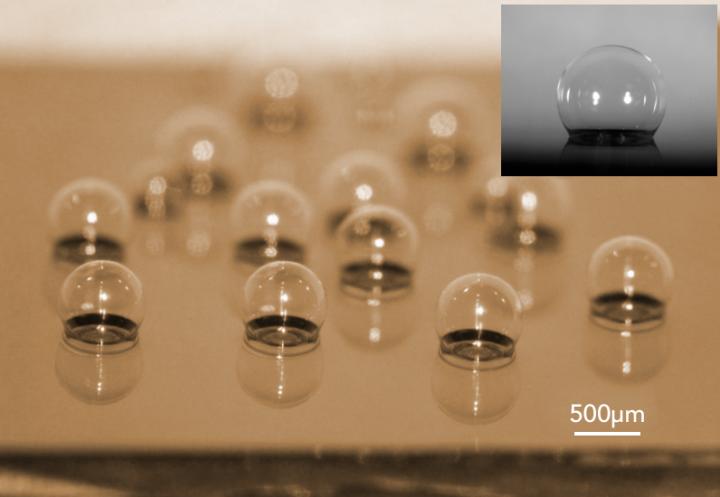An optical whispering gallery mode resonator can spin light around the circumference of a tiny sphere millions of times, creating an ultrasensitive microchip-based sensor for multiple applications.

A chip-scale glass microspherical shell sensor array blown on a silicon substrate. Insert is a near-perfect spherical shell. Courtesy of Tadigadapa Lab/Penn State.
"Whispering gallery mode resonators, which are basically optical resonators, have been intensely studied for at least 20 years," said Srinivas Tadigadapa, professor of electrical engineering at Penn State, where the resonator was developed. "What people have done is to take an optical fiber and touch the end with a blow torch. When the melted fiber re-condenses, it forms a sphere at the tip. This can be coupled to a light source to make a sensor."
That type of sensor consists of solid spheres and is not compatible with microfabrication methods. However, the Penn State researchers developed an innovative way to grow on-chip glass microspherical shells with incredible sensitivities that potentially can be used for motion, temperature, pressure or biochemical sensing.
The hollow borosilicate glass spheres are blown from sealed and pressurized cylindrical cavities etched into a silicon substrate. Using a glassblowing technique, the thin glass wafer, under high heat and external vacuum pressure, forms an almost perfect bubble.

The researchers grew arrays of spheres from 230 µm to 1.2 mm in diameter with wall thicknesses between 300 nm and 10 µm.
"The bottom of the sphere is thinned until it is basically a hole," Tadigadapa said. "You can put the light on the outside of the sphere but do all the chemistry on the inner face of the shell. You can bring in any analyte that you want to identify, but it goes on the inner surface.
This technology brings with it a lot of possibilities such as chemical sensing, vapor sensing, biophysical sensing, pressure sensing and temperature sensing.
The team discovered that the key to making a high-quality sensor is in making sure that the equatorial plane of the sphere, its center, is above the surface of the chip.
To get an understanding of the quality of their spheres, Tadigadapa's doctoral student Chenchen Zhang and recent doctoral graduate Eugene Freeman worked with Alexander Cocking, a doctoral student in the lab of Penn State laser expert Zhiwen Liu, also a professor of electrical engineering.
"We make the bubbles and then take them to Dr. Liu's lab to get the resonance levels and make the measurements," said Zhang. “This result will have particular significance for lab-on-a-chip biophysical sensing for disease sensing. Or by adding a polymer coating on the inside of the bubble, you could make a really sensitive humidity sensor."
The research has been published in the journal Scientific Reports (doi:10.1038/s41598-017-14049-w).